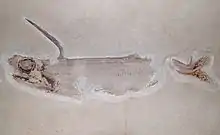Falcatidae
Falcatidae is a family of Paleozoic holocephalians.[1] Members of this family include Falcatus, a small fish from the Bear Gulch Limestone of Montana.[2] The family first appeared around the start of the Carboniferous, and there is some evidence that they survived well into the early Cretaceous,[3] though its putative Cretaceous members were also argued to be more likely neoselachians.[4]
| Falcatidae Temporal range: | |
|---|---|
 | |
| Falcatus specimen in Vienna | |
| Scientific classification | |
| Domain: | Eukaryota |
| Kingdom: | Animalia |
| Phylum: | Chordata |
| Class: | Chondrichthyes |
| Order: | †Symmoriiformes |
| Family: | †Falcatidae |
Genera
- Denaea [5]
- Falcatus[2]
- Ozarcus?[6]
- Stethacanthulus [5]
- Cretacladoides? – possible Early Cretaceous (Valanginian) member of the family[7]
References
- Coates, M.; Gess, R.; Finarelli, J.; Criswell, K.; Tietjen, K. (2016). "A symmoriiform chondrichthyan braincase and the origin of chimaeroid fishes". Nature. 541 (7636): 208–211. doi:10.1038/nature20806. PMID 28052054. S2CID 4455946.
- Lund Richard (1985). "The morphology of Falcatus falcatus (St. John and Worthen), a Mississippian stethacanthid chondrichthyan from the Bear Gulch Limestone of Montana". Journal of Vertebrate Paleontology. 5 (1): 1–19. doi:10.1080/02724634.1985.10011842.
- Guillaume Guinot; Sylvain Adnet; Lionel Cavin; Henri Cappetta (2013). "Cretaceous stem chondrichthyans survived the end-Permian mass extinction". Nature Communications. 4: Article number: 2669. doi:10.1038/ncomms3669. PMID 24169620.
- Alexander O. Ivanov (2022). "New late Carboniferous chondrichthyans from the European Russia". Bulletin of Geosciences. 97 (2). doi:10.3140/bull.geosci.1845.
- Ginter, M., Hampe., Duffin, C. 2010. Handbook of Paleoichthyology: Volume 3D- Paleozoic Elasmobranchii teeth. Verlag Dr. Freidrich Pfeil
- Alan Pradel; John G. Maisey; Paul Tafforeau; Royal H. Mapes; Jon Mallatt (2014). "A Palaeozoic shark with osteichthyan-like branchial arches". Nature. 509 (7502): 608–611. doi:10.1038/nature13195. PMID 24739974. S2CID 3504437.
- Iris Feichtinger; Andrea Engelbrecht; Alexander Lukeneder; Jürgen Kriwet (2018). "New chondrichthyans characterised by cladodont-like tooth morphologies from the Early Cretaceous of Austria, with remarks on the microstructural diversity of enameloid". Historical Biology: An International Journal of Paleobiology. 32 (6): 1–14. doi:10.1080/08912963.2018.1539971. S2CID 92392461.
This article is issued from Wikipedia. The text is licensed under Creative Commons - Attribution - Sharealike. Additional terms may apply for the media files.